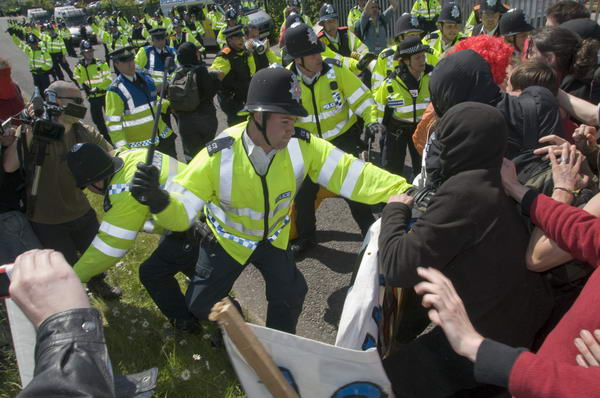I wasn’t feeling too well last Wednesday and didn’t feel up to going to Brighton to photograph the Shut ITT! demonstration there, a follow-up to Smash EDO’s ‘Carnival Against the Arms Trade‘ which I photographed last June. Had I made it his time there seems to have been a pretty good chance I would have ended the day with at least minor injuries from police action.

Police use batons on demonstrators outside EDO in June 2008
In June the policing had got pretty heavy-handed, and apparently even more so after I had left early thinking the demonstration was more or less over, when for some unaccountable reason the protesters were actually let on to the factory site and there was considerable mayhem all round.
This time things were tougher still, and not just for the protesters but also for photographers. On his blog, Jason Parkinson writes about the police actions: “I am sick to death of seeing my work colleagues getting hurt while trying to do their job” and talks about “a continuous pattern of abuse, ignorance, intimidation, harassment, surveillance and violence” directed at journalists, particularly photographers and videographers who need to be very much in the thick of things to get their pictures.
Two other photographers, Marc Vallée and Jonathan Warren have described how they were filmed and questioned before the start of the event, and told they were not allowed to photograph in the area where protesters were arriving.
Later, Vallée was assaulted by police (again!) and another photographer was bitten when a police dog was set on him, requiring medical attention. At least one photographer was pepper sprayed.
In my camera bag I carry a copy of the Guidelines for reporters, photographers and news crews for dealing with police at incidents published by the BPPA, CIoJ and NUJ in association with the Metropolitan Police, which on their reverse carry the Met’s guidelines for officers. As it states, these guidelines “have been agreed at senior levels by all parties. Please use them in a spirit of mutual professional respect to resolve any problems.”
These guidelines were adopted by all police forces in Britain in April 2007. They lay down general principles that recognise the law, the duty of the media to report from the scene of incidents, and the police duty to help them in doing so where possible.
These guidelines are simply not being followed so far as the policing of protests is concerned. As Jason ends his blog post: “There is no excuse to baton a photographer, no excuse to pepper spray a photographer and absolutely no excuse to use a dog as an offensive weapon against a photographer.” This isn’t my idea of “mutual professional respect.”